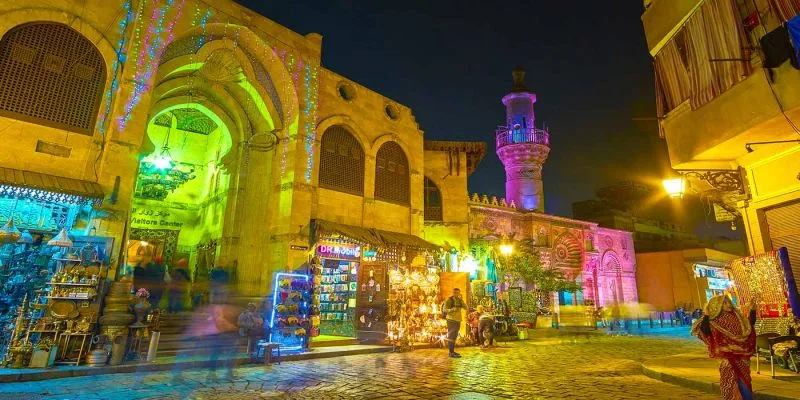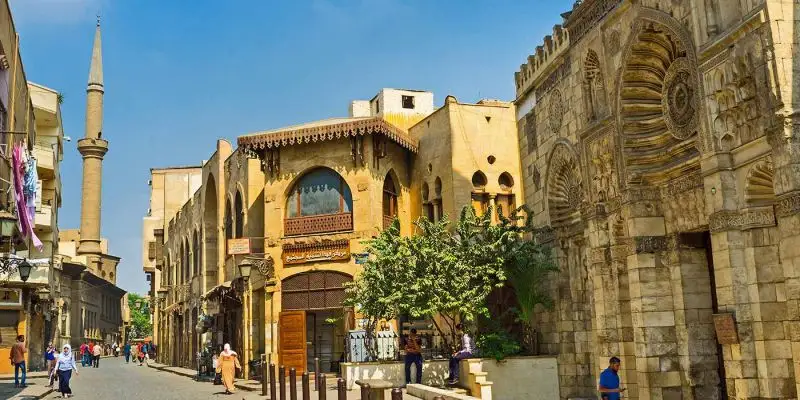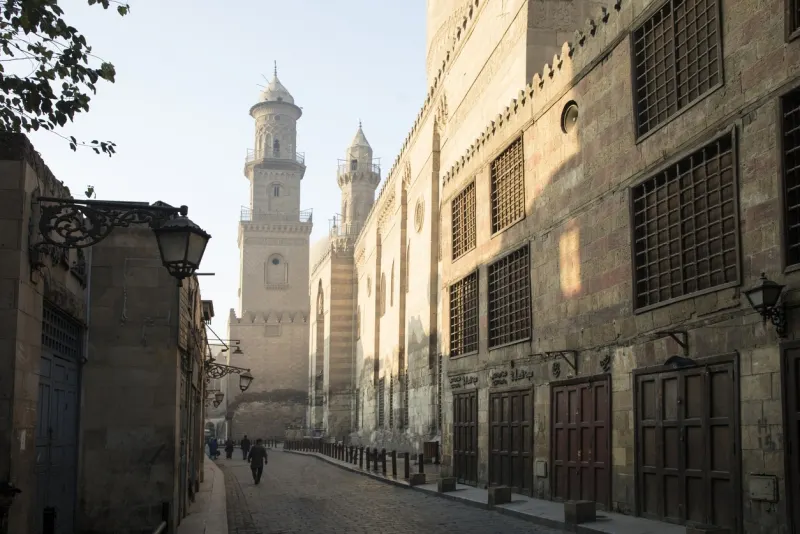Al Aqmar Mosque in El Muizz Street

Al Aqmar Mosque stands as one of Islamic Cairo's most significant architectural treasures, representing a pivotal moment in the evolution of mosque design in Egypt. Built in 1125 AD during the Fatimid period, this small yet extraordinary mosque along Al-Muizz Street introduced revolutionary architectural innovations that would influence Cairo's religious buildings for centuries to come. Known as the "Moonlight Mosque" for its luminous stone facade that glows under the Egyptian sun and moon, Al Aqmar Mosque offers visitors an intimate glimpse into the artistic achievements of Fatimid Cairo.
Located in the heart of historic Islamic Cairo, Al Aqmar Mosque remains one of the oldest surviving buildings in the medieval city of Al-Qahira. Its unique architectural features, intricate stone carvings, and historical significance make it an essential stop for anyone exploring Cairo's Islamic monuments. Despite its modest size compared to Cairo's grand mosques, Al Aqmar Mosque's influence on Egyptian Islamic architecture cannot be overstated.
Historical Background of Al Aqmar Mosque
The Fatimid Dynasty in Cairo
To understand Al Aqmar Mosque's significance, one must first appreciate the Fatimid context. The Fatimids conquered Egypt in 969 AD, originating from present-day Tunisia, and established Cairo (Al-Qahira) as their new capital. The Fatimids were Shi'a Muslims who brought their distinct theological perspectives and architectural traditions to Egypt, ruling until 1171 AD when Saladin established the Sunni Ayyubid dynasty.
During Fatimid rule, Cairo transformed into a magnificent Islamic capital filled with palaces, mosques, and grand public buildings. The Fatimids constructed the walled city that forms the core of Islamic Cairo today, with Al-Muizz Street serving as the main thoroughfare connecting the northern Bab al-Futuh gate to the southern Bab Zuweila gate.
Construction During Al-Amir's Reign
Al Aqmar Mosque was commissioned by al-Ma'mun al-Bata'ihi, who served as wazir (vizier or chief minister) to the Fatimid Caliph al-Amir bi-Ahkam Allah. Construction was completed in 1125 AD (519 AH in the Islamic calendar), during a period of Fatimid architectural flowering.
Historical sources offer slightly varying accounts of the mosque's origins, with some historians attributing its construction to the earlier Caliph al-Mustansir's reign, though most scholars accept 1125 AD under al-Amir as the correct date.
The mosque was built as both a place of worship and a statement of Fatimid power and sophistication. Its construction demonstrated the dynasty's commitment to architectural innovation and religious patronage, even as the Fatimid state faced increasing internal and external pressures that would eventually lead to its collapse later in the 12th century.

Al Aqmar Mosque is located on Al-Muizz li-Din Allah Street in Islamic Cairo, between Bab al-Futuh to the north and Al-Azhar Street to the south. The mosque sits in the northern section of this historic thoroughfare, near the Qalawun Complex and other significant Islamic monuments in Cairo's medieval district.
Revolutionary Architectural Features
The Innovative Offset Facade
Al Aqmar Mosque's most significant architectural innovation was its pioneering use of an offset facade—the first mosque in Cairo to employ this ingenious solution to a common urban planning challenge. The facade aligns perpendicular to Al-Muizz Street, maintaining a formal, symmetrical appearance facing the street, while the interior prayer hall sits at an angle to align with the qibla (the direction of Mecca that Muslims face during prayer).
This architectural innovation solved the problem of irregular street layouts that didn't align with the required prayer direction. Before Al Aqmar Mosque, Cairo's mosques either compromised their street presence with awkward angles or sacrificed proper qibla orientation. Al Aqmar Mosque's solution became widely adopted in subsequent Cairene mosque construction, influencing centuries of Islamic architecture in Egypt.
The Magnificent Decorated Facade
The facade of Al Aqmar Mosque represents one of the finest examples of Fatimid decorative stonework in Cairo. The entrance portal features three distinctive fluted hoods—one directly over the doorway and one on each side—creating an elaborate, sculptural frontage. These shell-like niches showcase the Fatimids' mastery of stone carving and their ability to create three-dimensional decorative effects.
Intricate inscriptions in both Kufic and Naskh Arabic calligraphy cover the facade, containing Quranic verses, historical information about the mosque's construction, and poetic dedications. The stone carving displays remarkable detail and craftsmanship, with geometric patterns, floral motifs, and calligraphic bands creating a visually rich surface that rewards close examination.
The facade's decorative program established patterns that later Cairo mosques would emulate and expand upon. The combination of structural innovation with elaborate decoration demonstrates the Fatimids' holistic approach to mosque design, where form, function, and aesthetics merged seamlessly.
The Elevated "Hanging" Mosque Design
Al Aqmar Mosque earned its distinction as one of Cairo's first "hanging mosques" due to its original construction above street level. The mosque was built atop a row of shops and a souk (marketplace), with the prayer hall elevated above these commercial spaces. This innovative design maximized the use of valuable urban real estate while providing rental income for the mosque's maintenance through the shops below.
Over the centuries, as Cairo's street levels gradually rose due to accumulated debris, construction, and urban development, the mosque's elevation decreased relative to its surroundings. Today, Al Aqmar Mosque appears to sit at street level rather than elevated above it, though careful observation reveals the original height difference. This phenomenon illustrates how Cairo's urban landscape has evolved over nine centuries, with the city literally rising around its historic monuments.

Architectural Elements and Interior Spaces
The Prayer Hall Design
The interior of Al Aqmar Mosque provides a stark contrast to the elaborately decorated facade, offering a simple, contemplative space for worship. The prayer hall follows a relatively modest plan compared to Cairo's grand congregational mosques, reflecting its original function as a neighborhood mosque serving the local Fatimid elite and their households rather than the entire city population.
The prayer hall features a flat wooden ceiling, a characteristic element of Fatimid mosque architecture. Some architectural historians suggest that the current ceiling dates from Mamluk-era restorations rather than the original Fatimid construction, as certain decorative elements and construction techniques appear to reflect later architectural styles unfamiliar during the Fatimid period.
One of the mosque's most pleasant features mentioned by visitors is the cooling breeze that flows through the interior spaces. This natural ventilation results from careful architectural planning that creates air circulation patterns, providing relief from Cairo's heat—a crucial consideration in pre-modern mosque design.
The Courtyard Space
Al Aqmar Mosque includes a small open courtyard adjacent to the covered prayer hall, following the traditional Islamic mosque layout of sahn (courtyard) and prayer hall. This outdoor space allows natural light to enter the building while providing additional space for worshippers during crowded prayer times.
The courtyard's modest scale reflects the mosque's neighborhood function rather than serving as a major congregational mosque for Friday prayers. This intimate scale contributes to Al Aqmar Mosque's charm, offering visitors a more personal experience compared to the vast courtyards of Cairo's imperial mosques.
Mamluk Renovations and Historical Changes
Restoration Under Yalbugha al-Salimi
Al Aqmar Mosque underwent significant restoration during the Mamluk period under Amir Yalbugha al-Salimi in the 14th century. The Mamluks, who succeeded the Ayyubids as rulers of Egypt, demonstrated respect for Cairo's Fatimid architectural heritage even while subscribing to different religious interpretations. Yalbugha al-Salimi's renovations preserved the mosque's essential Fatimid character while making necessary structural repairs and updates.
Some architectural historians attribute certain features of the current structure to these Mamluk renovations, particularly elements of the ceiling construction that employ techniques not typically found in Fatimid buildings. This layering of architectural periods adds complexity to understanding Al Aqmar Mosque's construction history but also demonstrates the building's continuing importance across successive Islamic dynasties.
Adaptations Through the Centuries
Like many of Cairo's historic mosques, Al Aqmar Mosque has been adapted and modified throughout its nearly 900-year history. Various ruling powers have undertaken repairs following earthquakes, structural deterioration, and other damage. These interventions, while altering some original features, have ensured the mosque's survival into the modern era.
The mosque's continuing function as an active place of worship, rather than merely a historic monument, has necessitated ongoing maintenance and occasional updates to accommodate contemporary needs while respecting historical integrity.

Al Aqmar Mosque was the first mosque in Cairo to use an offset facade design, allowing the street-facing facade to align with Al-Muizz Street while the interior prayer hall angles toward Mecca. This innovative solution influenced Cairo mosque architecture for centuries and established new standards for urban mosque design.
Customize Your Dream Vacation!
Get in touch with our local experts for an unforgettable journey.
Plan Your Trip
Al Aqmar Mosque's Location on Al-Muizz Street
The Historic Heart of Islamic Cairo
Al Aqmar Mosque occupies a prime location on Al-Muizz li-Din Allah Street (commonly shortened to Al-Muizz Street), the main north-south thoroughfare through historic Islamic Cairo. This street, named after the Fatimid Caliph who founded Cairo, served as the ceremonial and commercial spine of the medieval city, lined with mosques, madrasas, palaces, and markets.
Al-Muizz Street's northern section, where Al Aqmar Mosque is located, underwent extensive restoration in the early 21st century. The Egyptian government, with support from international conservation organizations, restored building facades, improved infrastructure, and created a pedestrian-friendly environment. This restoration project transformed the street into one of Cairo's most atmospheric and photogenic historic districts.
Nearby Historic Monuments
Al Aqmar Mosque sits amid a concentration of Cairo's most significant Islamic monuments. The impressive Qalawun Complex, built by the Mamluk Sultan in the late 13th century, stands nearby, featuring a hospital, mausoleum, and madrasa. The Al-Azhar Mosque and University, founded by the Fatimids in 970 AD as one of the world's oldest continuously operating universities, lies a short walk to the south.
This clustering of historic buildings makes Al-Muizz Street an ideal location for exploring Islamic Cairo's architectural heritage. Visitors can easily combine a visit to Al Aqmar Mosque with tours of other nearby monuments, gaining a comprehensive understanding of Cairo's Islamic architectural development from the 10th through 19th centuries.
The Name "Moonlight Mosque"
Origins of the Poetic Title
Al Aqmar Mosque translates as "the Moonlight Mosque" or "the Moon Mosque," a poetic name that reflects the building's aesthetic qualities. The limestone facade, with its pale gray color and intricate carved details, exhibits a luminous quality that becomes particularly striking under bright sunlight and moonlight. The stone seems to glow with an inner radiance, justifying the evocative name.
Some scholars suggest the name may also reference symbolic associations between the moon and Shi'a Islam, particularly the Fatimid dynasty's veneration of Ali, whose titles sometimes included lunar imagery in Islamic poetry and theology. However, the most straightforward explanation remains the visual appearance of the beautifully carved stone facade under varying light conditions.
Aesthetic Impact and Visual Character
The nickname "Moonlight Mosque" captures Al Aqmar's distinctive character among Cairo's Islamic monuments. While many of Cairo's mosques impress through monumental scale—the massive citadel mosque of Muhammad Ali, the towering minarets of Sultan Hassan, the vast courtyard of Ibn Tulun—Al Aqmar Mosque captivates through refined decoration and intimate scale.
Photographers and artists particularly appreciate how changing light conditions throughout the day transform the facade's appearance, with shadows accentuating the three-dimensional carved details and the stone's color shifting from warm golden tones in direct sunlight to cool silvery grays in shade.

Al Aqmar Mosque was built in 1125 AD (519 AH) during the Fatimid period. It was commissioned by al-Ma'mun al-Bata'ihi, the vizier to Fatimid Caliph al-Amir bi-Ahkam Allah, making it one of the oldest surviving Fatimid buildings in Cairo.
Visiting Al Aqmar Mosque Today
Planning Your Visit to Islamic Cairo
Al Aqmar Mosque welcomes visitors throughout the week, though visiting hours may vary, and the mosque closes during prayer times, particularly Friday congregational prayers. Visitors should dress modestly, with women covering their shoulders and knees and bringing a headscarf. Shoes must be removed before entering the prayer hall.
The mosque's location on pedestrianized Al-Muizz Street makes it easily accessible on foot when exploring Islamic Cairo. Many visitors incorporate Al Aqmar Mosque into walking tours that include other nearby monuments. The recently restored street environment provides a pleasant setting for strolling between historic sites.
What to Look For During Your Visit
When visiting Al Aqmar Mosque, pay particular attention to the facade's intricate stonework, especially the three fluted hoods and the calligraphic inscriptions. The offset angle between the facade and the interior prayer hall becomes apparent when you enter the building—notice how the entrance passage subtly angles to accommodate the different orientations.
Inside, observe the simple elegance of the prayer hall and the pleasant natural ventilation. While the interior lacks the elaborate decoration of the exterior, this simplicity creates a contemplative atmosphere appropriate for prayer and reflection.
Photography is generally permitted outside the mosque, though visitors should be respectful and ask permission before photographing people praying or in the immediate vicinity.
Al Aqmar Mosque in Cairo's Islamic Heritage
Architectural Influence and Legacy
Al Aqmar Mosque's architectural innovations, particularly the offset facade solution, influenced subsequent mosque design throughout Cairo and the broader Islamic world. Many later Cairo mosques adopted similar approaches when confronting the challenge of reconciling street alignment with qibla orientation.
The facade's decorative program established precedents for elaborate stone carving on mosque exteriors, a tradition that reached its apex in Mamluk-era buildings like the Sultan Hassan Mosque and the Qalawun Complex. The integration of functional architecture with refined decoration became a hallmark of Cairo's Islamic architecture.
Conservation and Preservation Efforts
As one of the oldest surviving Fatimid buildings in Cairo, Al Aqmar Mosque represents an irreplaceable link to Egypt's medieval Islamic past. Conservation efforts have focused on stabilizing the structure, preserving the intricate stone carvings from weathering and pollution damage, and maintaining the building's historic character while ensuring it can continue functioning as an active mosque.
The broader restoration of Al-Muizz Street has improved conditions around Al Aqmar Mosque by reducing vehicle traffic, controlling pollution, and creating a more sympathetic urban environment for historic monuments. These efforts help ensure that future generations can continue appreciating this architectural masterpiece.
Exploring Islamic Cairo's Monuments
Beyond Al Aqmar: Other Fatimid Sites
Visitors interested in Fatimid architecture should also explore other surviving monuments from this dynasty. The Al-Azhar Mosque (970 AD) offers a much larger example of Fatimid religious architecture, though it has been extensively modified by subsequent dynasties. The Al-Hakim Mosque (completed 1013 AD) near Bab al-Futuh preserves substantial Fatimid elements despite Mamluk and modern restorations.
The gates of Fatimid Cairo—Bab al-Futuh, Bab al-Nasr, and Bab Zuweila—demonstrate Fatimid military architecture and urban planning. These massive stone gates, built by Armenian architects in the late 11th century, still dominate their surroundings and provide spectacular viewpoints over Islamic Cairo.
The Complete Islamic Cairo Experience
A comprehensive tour of Islamic Cairo should include monuments from all major Islamic dynasties that ruled Egypt. Ayyubid sites like the Citadel of Saladin, Mamluk masterpieces such as the Sultan Hassan complex and the Madrasa of Qaitbay, and Ottoman-era buildings like the Muhammad Ali Mosque collectively tell the story of Cairo's development as one of the Islamic world's greatest cities.
Khan el-Khalili bazaar, Coptic Cairo's ancient churches, and the Museum of Islamic Art provide additional dimensions to understanding Cairo's rich cultural heritage. Together, these sites offer unparalleled insight into the artistic, architectural, and cultural achievements of Islamic civilization.
Al Aqmar means "the moonlight" or "the moon" in Arabic. The mosque earned this poetic name because its pale gray limestone facade glows with luminous beauty under sunlight and moonlight, creating a distinctive silvery appearance that sets it apart from other Cairo mosques.
Yes, tourists can visit Al Aqmar Mosque on Al-Muizz Street in Islamic Cairo. The mosque welcomes visitors outside prayer times. Modest dress is required—women should cover shoulders and knees and bring headscarves. Visitors must remove shoes before entering the prayer hall.
Al Aqmar Mosque is generally open to visitors daily outside prayer times, though hours may vary. The mosque closes during Friday congregational prayers and the five daily prayer times. Visit early morning or late afternoon for the best experience exploring Islamic Cairo's monuments.
Al Aqmar Mosque is surrounded by Cairo's Islamic landmarks including the Qalawun Complex, Al-Azhar Mosque, Bab al-Futuh gate, Sultan Hassan Mosque, and Khan el-Khalili bazaar—all located along or near Al-Muizz Street in Islamic Cairo, making it easy to visit multiple sites in one day.
From downtown Cairo, take a taxi or ride-share to Al-Azhar Street or Bab al-Futuh area. Al-Muizz Street is pedestrianized, so walk north from Al-Azhar Mosque or south from Bab al-Futuh to reach Al Aqmar Mosque. Many Cairo day tours include Islamic Cairo and Al-Muizz Street monuments.





























